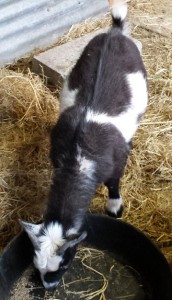A couple of weeks ago, I wrote about the routine of bringing the goats out in the morning. Last week, we had a little deviation in the pattern, all to do with Thistle, our little wether.

I had let all the girls out onto the hillside and I’d let Thistle out to play on the milkstand while I was tending to little Rose in the shed. He had his nose in the feeder and was happily manging on alfalfa pellets. Two seconds later, I noticed out of the corner of my eye that he’d lifted his head and was shaking it back and forth. Oh, and by the way, he was also *foaming at the mouth*. Yellow foam was spraying all over as he shook his head from side to side and bleated his distress. Scary!
I called for backup and Matthew came out immediately to hold Thistle for whatever weird doctor-y biz we’d need to do.
Thank god for the internet, can I just say? I ran to the computer and googled a few of my best sources for “yellow foam goats”. Lots of info on that, if you can imagine. All the signs pointed to him either being poisoned (but there were no other symptoms) or having bloat (aka too much gas in the tummy (really, it’s called the ‘rumen’ but when it’s owie, it’s called a ‘tummy’). Goats get bloat from eating too much rich food, generally, or just too much food, or something weird. It’s a delicate balance. Luckily, we had on hand the easiest and quickest remedy for bloat: baking soda. Just like you’d give a human-person.
I filled a pint glass of water, and put in about a 1/2 tsp of baking soda, then I used a dosing syringe to administer the liquid to him. He drank it happily, like he knew it was just what he needed.
A moment later he began belching. A lot. Like a really lot. Like maybe he was belching the goat alphabet and was really impressing the other goats, who’d gathered to watch.
Anyway, that went on for a while, while Matthew held him and I rubbed his tummy. Matthew, sadly, was right in the line of fire of those belches and not only were they loud they also smelled like…something less than pleasant, let’s just say.
When things calmed a bit, Matthew set Thistle down on the grass and he scampered off. I kept a keen eye on him that day, but he was fine and has been ever since!
Blessed be the easy problems, by which we learn! Blessed be simple solutions! (See what I did there? “Solutions”? Baking soda in water? Okay, that’s enough…)
Clearly, I am not a vet, and there are lots of reasons why ruminants get sick and lots of treatments that are suggested for their healing, from Granny Aching’s turpentine cure to complicated nutritional and medicinal options. To learn more about goat husbandry in general, the best site I’ve found is at Fias Co Farm. There are many forum-type sites that are full of good info as well, including the Goat Spot and one of my personal favorites, the ning group for Nigerian Dwarf Goats. Enjoy.
















